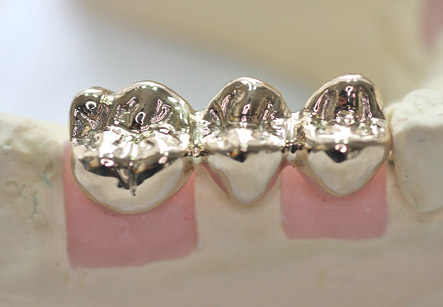Metal Bridge
Introduction
If a missing tooth is present and if the patient follows good oral as well as dental hygiene practices, the prudent choice for the tooth replacement is a bridge.
A dental bridge is a dental technique of restoration utilized for replacement of missing tooth. It adheres to contiguous teeth or other implants. These bridges prevent dental problems like decay of tooth, speech disturbances and shifting teeth. There are several different types of bridges available depending upon the location of the missing teeth, the condition of the surrounding teeth and choice of the patient.
Purpose of a bridge:
The tooth restored with this bridge usually breaks only if the underlying tooth structure has fractured or decayed.
The most essential purpose of fixing a metal bridge is for preventing the contiguous teeth from shifting in a place created by missing teeth. This shifting also causes change of bite, sore jaws and problems in the jaw joint. Such uneven bite makes chewing difficult and can cause a person to grind and clench instead. The teeth opposite to a missing tooth can become loose and sometimes extrude from the place. Missing teeth also compromise dental and oral hygiene causing tooth decay and various gum diseases.
Iran offers a superior Dental treatments that is world best quality. For patients from the USA, and Europe for example, the savings can be 60% or more

The metal bridge can be made entirely of metal or it can be fused to porcelain to make PFM (porcelain fused to metal) bridge. The dentist decides about which material is used for the dental bridge work after thorough dental examination and discussion with the patient.
Full Metal Bridges:
This type of dental bridges is usually made from gold alloys but it can be made from platinum, palladium, mercury and many more.
Porcelain fused to metal bridge:
This bridge consists of a metal core inside and a layer of porcelain outside which are blended together. PFM bridges look just like normal teeth.
Procedure
There are several steps in the making of this bridge. First, the dentist examines the teeth and decides that the patient is a candidate for a bridge or not. Once the decision is made, a baseline X-ray film of teeth can be taken. The process goes as given:
• In the first visit, the dentist prepares the teeth on either side of the defect left by a missing tooth. A mild anesthetic medicine is injected to numb the area. Then the cosmetic dentist makes enough space between the teeth on either side so as to accommodate the thickness of the crown. If these teeth already have fillings, they are left in place serving as a foundation for the crown.
• The dentist makes an impression, from which the bridge, false tooth and crowns are made in a dental laboratory. Until the next visit, patient is made to wear a temporary bridge. This temporary bridge protects the teeth and gums till the next visit. Or else, a Flipper appliance is used in the place of missing tooth which can also serve as temporary bridge. A Flipper is a false tooth attached via either a wire or a plastic piece to the roof of the mouth awaiting the permanent bridge.
• On the second visit, the temporary bridge is removed and new permanent bridge is fitted and checked and adjusted for any bite problems. If none, the new bridge is cemented to the teeth permanently.
Properties of metal bridge:
1. Metal bridges have ability to withstand heavy stresses from chewing forces. They usually do not chip or break; therefore they are long lasting dental restorations.
2. The tooth restored with this bridge usually breaks only if the underlying tooth structure has fractured or decayed.
3. Eating sticky foods and candy should be avoided as it can make the metal bridge loose, as is the case with all types of bridges.
4. Metal bridges cause some wear on the opposing tooth. It is especially true for patients who have habit of grinding their teeth or having a heavy bite.
5. The metal bridges are usually used in restoration of back teeth such as molars and premolars because of their appearance and also because there are more biting stresses on these teeth which can be tolerated by metal.
6. The look of all metal bridge is not natural and can affect the appearance. Even with PFM bridge, a blue line is visible above the gum line indicating presence of metal.
7. People with allergy to metal are not suitable candidates for a metal bridge.